Gabriel Karawani, Director & Co-Founder
More blogs by this author
Gabriel Karawani, Director & Co-Founder
More blogs by this authorA common question that comes up when discussing ChatGPT in the context of knowledge, document and information management, is something along the lines of: "When or how will ChatGPT be able to discover our enterprise content, such as SharePoint Pages or Documents stored in Teams and SharePoint?"
In this blog:
Despite a reputation of having been proven wrong a few times when saying "it will never happen," I'm going to stick my neck out and say: "ChatGPT is not going to 'discover enterprise content' ... ever." I obviously have lots of caveats tied to this statement. The most important one being that I am referring to "discovering".
Without being an AI expert or a ChatGPT expert, I believe it's fairly clear ChatGPT is not designed to carry out scaled discovery of content within enterprise boundaries (i.e. within your Microsoft 365 SharePoint/Teams content). If my understanding is correct, it is in fact not designed to discover content at all.
As per Wikipedia's page on GPT-3: "Generative Pre-trained Transformer 3 (GPT-3) is an autoregressive language model released in 2020 that uses deep learning to produce human-like text. Given an initial text as prompt, it will produce text that continues the prompt."
In other words, ChatGPT doesn't look for or give you answers, unless you provide it with a prompt to do so.
However, this does not mean that it cannot work with you content. On the contrary - it will work with (and respond to) the content that you feed it in the prompt.
You may have come across – or you might be using – Microsoft Teams Premium, which is integrated with ChatGPT. It's tempting to argue that ChatGPT automatically gives me outputs from my Teams Meetings, the content of which could be considered enterprise content.
What is actually happening here is that the transcribed text from a Teams meeting is fed to ChatGPT (i.e. the transcription is part of the prompt sent to ChatGPT) and in return GPT-3.5 generates suggestions for tasks and actions that have come out of the meeting. If you consider the spoken word (which is transcribed to text) as enterprise content, fair enough. Either way, this is only happening because the Teams Meeting was enabled (see "Microsoft 365 Copilot" below) to send over the transcribed text for that meeting.
So in practical terms, imagine a scenario where during a meeting, Sally says "Bob, it would be great if you could dig out the quarterly sales numbers for Q4 last year, so we can compare them in our next meeting."
What we should not expect from the GPT service alone is that it performs some sort of an internal search, and digs it out for us (or Bob). In other words, we will not see something like this from GPT without us feeding the information to GPT:
"Bob will find the sales number for Q4 last year (suggested file here: 2022-Q4-Sales-Results.pdf)."
What we can expect is that GPT auto-generates a Suggested Task as follows:
"Bob will find the sales number for Q4 last year."
Below are some examples from Microsoft's blog announcing Teams Premium:
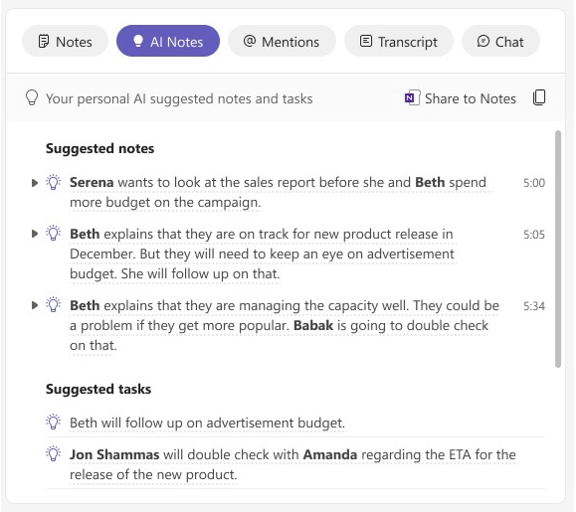
No, it doesn't do that directly or proactively - it requires something or someone to feed the content to it. (See seperate blog about Microsoft Copilot published March 2023)
In other words, in order for ChatCPT to 'look at' internal enterprise content such as pages or documents, the user (or some automation acting on behalf of the user) will have to grab the textual content, and send it in a prompt to ChatGPT with an instruction of what to do with it.
So, if I want ChatGPT to summarise a document, I would have to copy the document text, then move over to ChatGPT and enter something like: "Summarise this: [past my document content here]"
A pseudo prompt could look something like this:
“Summarise the following document in maximum 3 paragraphs, and provide a list of document chapters, each with a maximum 50 word summary of each chapter, followed by up to 10 suggested keywords for the document: [DOCUMENT BODY]”
Of course, this can be done programmatically through APIs, and this is where Microsoft 365 Copilot comes into the picture (announced on March 16 2023) which provides premium capabilities to automate this capability across Microsoft Office, Outlook at Teams (not just Teams Meetings). For instance, the automatic creation of a proposal, based on existing documents and emails, or in other areas of content service automation.
Microsoft's solution that will allow ChatGPT (or other Large Language Models) to do something with your own content is Microsoft 365 Copilot. Announced by Microsoft on March 16 2023, this capability (which is in its early stages) will help business users combine their prompts (from within a Microsoft app such as Word) with content in their Microsoft 365 tenant (using Microsoft Graph). This combined prompt is then sent to the LLM (Large Language Model, such as ChatGPT), resulting in a user and business relevant response. The key thing here to note is that ChatGPT did not itself go and grab or discover any content. You can read in this blog introducing Microsoft 365 Copilot and Business Chat.
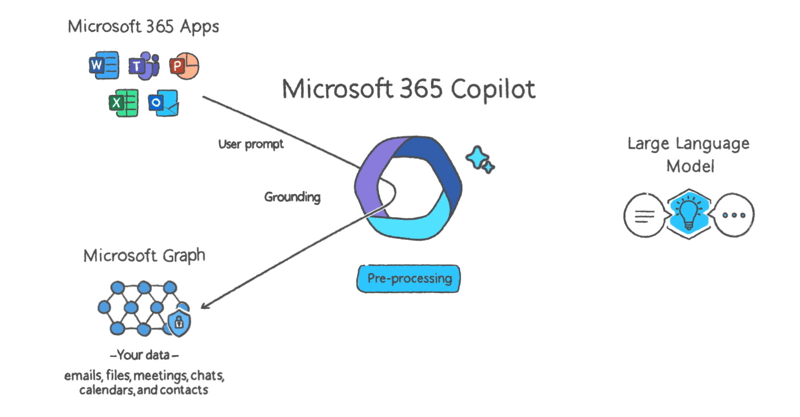
So to put this into perspective, ChatGPT does a good job of summarising a piece of content when it is available in the public domain. But without something like Microsoft 365 Copilot, it would not know what to do with any of your internal content.
Here's a real example, using a publicly available article authored by Chris Marino, from Enterprise Knowledge (linked here).
My prompt to ChatGPT was:
"Summarise in maximum 200 words an article called 'Is ChatGPT Ready for the Enterprise?' by 'Chris Marino' and add a list of headlines with a one line recap for each section."
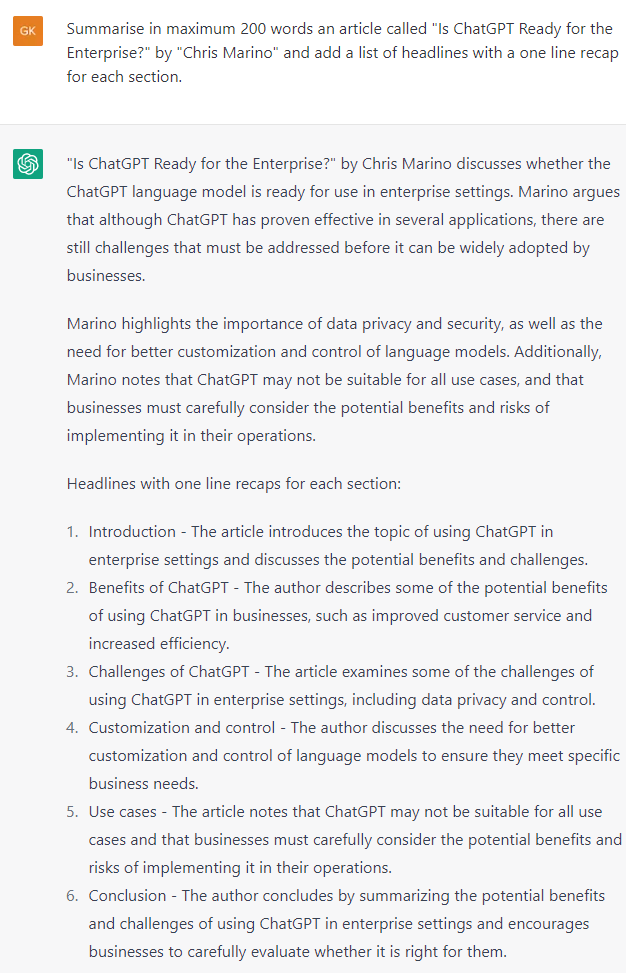
Not a bad summary at all, with 6 headlines summarised – although the actual headlines are not correct. ChatGPT has summarised its own interpretation of the key themes as headlines, but it did – as requested – provide a one-line summary for each of these.
So while this is impressive, the limitation is crucial. I had to prompt it (using either the actual text of a document, a link to a publicly available article, or in this case a clear instruction on how to find that publicly available article), which allowed the pre-trained GPT service to perform its magic.
So let me now compare this, by creating a similar prompt, where I want ChatGPT to summarise internal content that I know exists in our own Atlas Digital Workplace for ClearPeople. The result from ChatGPT is now very different when asking as follows:
"Summarise in maximum 200 words an internal article called 'Viva Topics' by 'Gabriel Karawani' and add a list of headlines with a one line recap for each section."
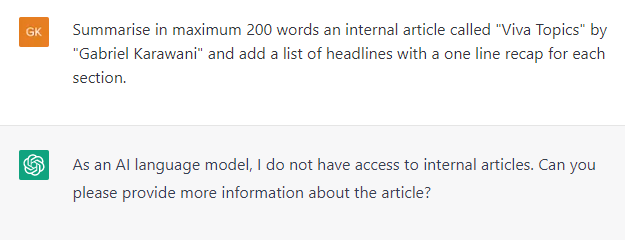
The above is of course purely using the public ChatGPT service, without the assistance of Microsoft 365 Copilot or any other integration with internal content.
What is certain is that any enterprise ChatGPT capability will come at a premium (such as Teams Premium) as it requires some not-insignificant computing resources to run, plus any investments you might consider for bespoke/custom models (aka 'fine-tuning').
Running such a service against all your enterprise content would therefore come at a high price (and consume a lot of energy). Apart from the cost question, you should also ask 'why?'.
And here are some other questions organisations will have to ask themselves:
It's early days for GPT – but it is exciting nonetheless when considering its possible use cases. Internally, custom-trained (fine-tuned) GPT models with internally relevant datasets are likely to be a must, to provide sensible outcomes for your users.
A year from now, I am sure we will see it in action for lots of creative and innovative use cases that we have not even thought of yet. Have a look at the Forbes article with a list of job areas that are likely to feel an impact (for better or worse).
My prediction, however, is that enterprise content discovery is not one of those we will see successfully implemented.
Before publishing this, I thought I better check if ChatGPT agrees with the general conclusion:
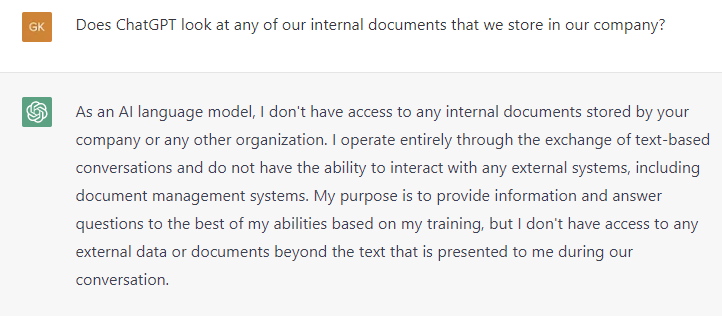
References:
|
|
Real scenarios for using Microsoft 365 Content Services and SharePoint SyntexWatch this webinar where Microsoft, ClearPeople and their customer, Northumbria Water Group, discuss real and practical scenarios for how NWG uses Syntex and what they're achieving with it. |
Subscribe to our newsletter
This site is protected by reCAPTCHA and the Google Privacy Policy and Terms of Service apply.

This site is protected by reCAPTCHA and the Google Privacy Policy and Terms of Service apply.